Rumors have been swirling for years about mainstream smartwatches gaining camera support, from a Samsung patent in 2017 to more than a few from Apple over the years. However, even though these reports repeatedly suggest companies are exploring the area of wearable photography, nothing has yet come of it.
Realistically, there may not be much demand for cameras on smartwatches. Among the concerns I commonly hear from smartwatch users, wishing for a camera barely makes the list. Nearly all the flagship smartwatches have to be paired with a compatible smartphone that’s guaranteed to have a better camera than anything that can be crammed into a wrist-sized device.
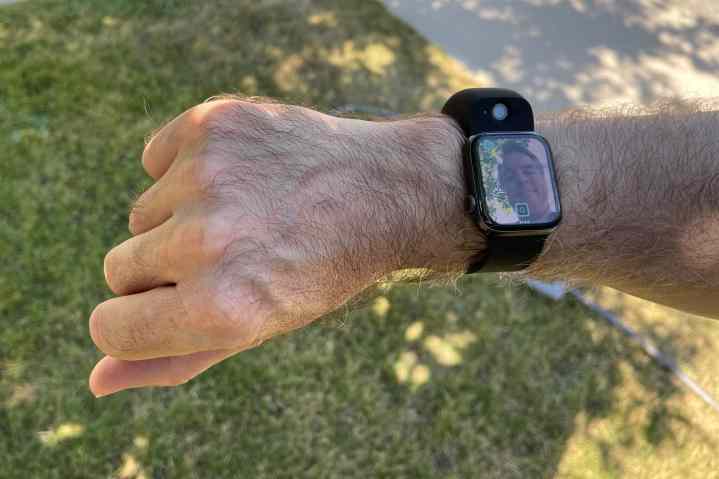
So, other than some pretty obscure smartwatches from a handful of Chinese companies you’ve likely never heard of, no one seems to be in any hurry to add a camera to their wearables. Samsung tried it about ten years ago with the first two iterations of Galaxy Gear but quickly abandoned the idea after that. Oppo recently showed off a prototype under-display smartwatch camera but hasn’t said when that will be ready for prime time. Meta’s rumored Facebook smartwatch was also supposed to include a dual-camera system, but that now appears dead in the water.
Of course, just because Apple hasn’t embraced a camera on the Apple Watch doesn’t mean there isn’t at least some demand for the feature. Although the Apple Watch still needs to be paired with an iPhone, advancements over the past few years have made it quite capable of functioning independently — especially for users who opt for the cellular-capable models. If you’re an Apple Watch owner who likes to go out for a run or spend a day at the beach without your iPhone in tow, it’s not a bad idea to have a camera on your wrist. And I recently tried a watch band that let me do just that.
A camera for the Apple Watch
Enter Wristcam. This replacement watch band with a built-in camera is a clever solution for shutterbugs who want to venture out with nothing more than their Apple Watch on their wrist without the risk of missing any photo opportunities.
Since Apple doesn’t offer any native support for cameras in WatchOS, Wristcam has had to get pretty creative. The company has done an admirable job of building a very functional accessory despite the limitations of Apple Watch hardware and software.
For example, the Apple Watch doesn’t offer any way to physically connect an external accessory, nor does WatchOS have any clue what a camera is. Hence, Wristcam is an Apple Watch strap that attaches like any regular band and links up with the Apple Watch via Bluetooth and Wristcam’s own WatchOS app.
Design and specs
Since Wristcam contains two cameras, a battery, Bluetooth and Wi-Fi hardware, and 8GB of flash storage, it shouldn’t come as a surprise that it’s bulkier than the average Apple Watch band. If anything, at 0.41 inches at its thickest point, it’s impressive that it’s not larger considering the technology packed inside.
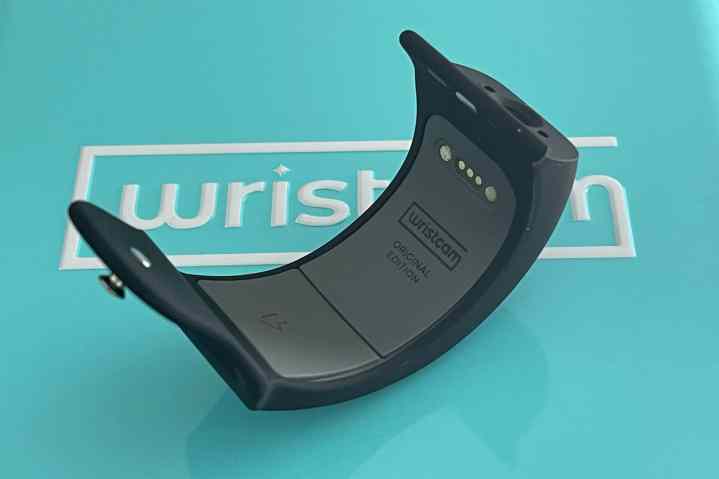
Still, stylish it’s not. Nobody is going to accuse Wristcam of being a fashion accessory, but that’s not really the point. This is about function over form, and it’s probably fair to say this won’t be an issue for most situations where you’d want a camera on your wrist. I’ve worn it with my 44mm Apple Watch for a few days, and it still feels bulky, but not so much that it bothers me when I’m out cycling or going for a walk.
Wristcam’s less than subtle appearance also means it isn’t intended to be a spy cam — a good thing, in my opinion. While you can snap pictures with Wristcam more surreptitiously than pulling out your smartphone, it’s still pretty obvious to anybody paying attention — and there’s a bright LED to help ensure they are.
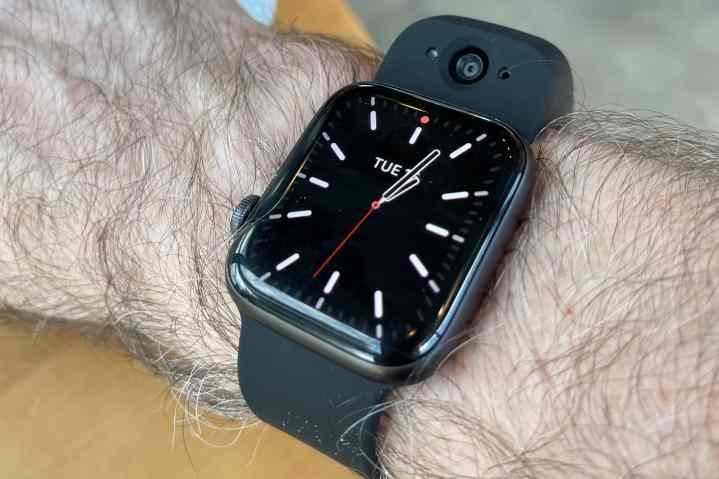
Like most Apple Watch bands, Wristcam comes in two pieces. The strap that attaches to the top of your Apple Watch contains the Wristcam hardware, while the bottom part is just a typical strap in the style of Apple’s sport band.
Wristcam has two cameras to handle both selfies and normal photography. A 2-megapixel (MP) camera located directly above the watch face points toward you when looking at your Apple Watch, while an 8MP shooter is aimed outward in a perpendicular direction, in line with the plane of your hand. A discrete button below the main camera lets you quickly snap pictures or start recording video without opening the Wristcam app.

Photos and videos are saved to the internal 8GB flash memory, where they can be later downloaded to your iPhone over a Wi-Fi connection. A built-in rechargeable battery promises about a day of typical use, although video recording will consume more energy, as will leaving the active preview window open on the Apple Watch.
Setting up Wristcam
Wristcam comes in a Tiffany blue metal tin with a custom charging cable that magnetically attaches to a port on the inside of the strap in such a way that you can still charge your Apple Watch at the same time. The tin also includes a dual-port USB adapter so you can plug the Apple Watch and Wristcam charging cables into a single wall outlet, which I thought was a nice touch.

The instructions recommend charging Wristcam for at least an hour before trying to set it up, which is done by downloading the Wristcam app and using that to pair it up over Bluetooth. As long as the Wristcam has enough juice and is on the charger, the app should detect it and handle the pairing when you first open it.
The iPhone Wristcam app also goes through the other usual security and privacy steps of asking you to grant access to your photo library so it can save photos and videos there, granting access to location services so it can geotag your photos, and sharing your Wi-Fi credentials with Wristcam so it can transfer photos from the internal storage to your iPhone.
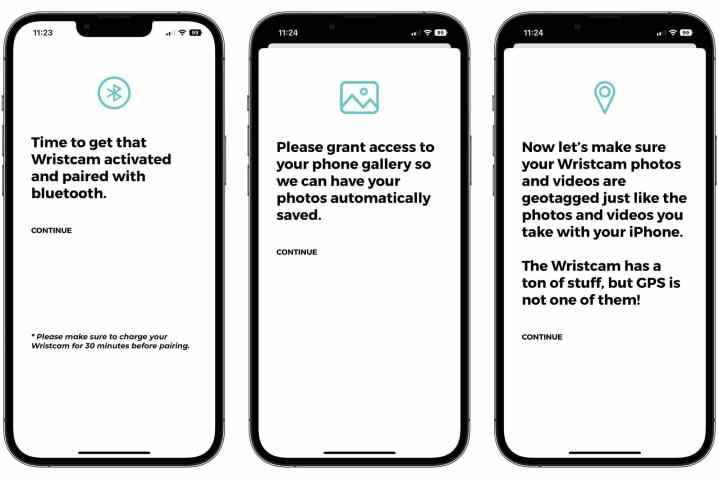
Like any other WatchOS app, you’ll need to install the Wristcam app on your Apple Watch separately. Still, the good news is that once Wristcam has been paired with your iPhone, it automatically transfers that pairing to your Apple Watch, so there’s nothing special you have to do on that side beyond simply opening the app.
The iPhone app is also used to manage and install firmware updates for Wristcam, and it’s a good idea to check for one as soon as you’ve finished setting everything up, as the company has been adding features and improvements pretty aggressively. In my case, Wristcam came with version 0.2.835 installed, but a “critical” 0.5.1006 update was waiting for me.
What it’s like having a camera on your wrist
Once everything is set up, taking photos with Wristcam is as easy as opening the app, pointing the camera at your subject, and tapping the capture button. Much like the iPhone’s built-in camera app, an additional button lets you easily switch between the front and rear cameras.
If you’re content to shoot somewhat blindly, you don’t even need to open the Wristcam app; a single press of the button below the main camera lens will immediately capture a photo to Wristcam’s built-in storage. This works even if Wristcam isn’t attached to an Apple Watch since Wristcam is effectively just a self-contained camera system with a Bluetooth companion app.

Similar methods work for recording video. In the Wristcam app, the video pane can be accessed by swiping over to the next screen to the right, or you can long press the hardware button to begin recording without launching the app. The LEDs beside both cameras will flash green while video recording is in progress, and you can stop recording with a single press of the hardware button. You can also open the Wristcam app to monitor a recording in progress and stop it from there.
The hardware button is particularly useful for taking quick shots since the Wristcam app takes a few seconds to start up. To conserve battery power, Wristcam goes into a low-power hibernation mode when it’s not in use, so it can take around 2–3 seconds for the WatchOS app to connect and be ready to go.

Turning the Digital Crown in the app lets you select one of three aspect ratios: 1:1, 4:3, and 16:9 for the main camera or the portrait-oriented 1:1, 3:4, or 9:16 for the front selfie camera. Note that the maximum vertical resolution of the main camera is 2160 pixels, so you’ll only get 8MP photos when shooting in 16:9 mode, which works out to 3840 x 2160. Similarly, the selfie camera has a maximum horizontal resolution of 1080 pixels (since it takes photos in portrait mode), so you’ll need to shoot 9:16 pictures to get the full 1920 x 1080 size.
In video mode, the Digital Crown lets you choose whether to turn video stabilization on or off, which also affects video resolution. With stabilization off, both cameras can record 1080p video, which Wristcam calls “HD Action Mode,” while turning on video stabilization drops that down to 720p “HD Mode.” In either mode, recording is limited to 30 frames per second.
Transferring photos and videos
Photos and videos are saved to Wristcam’s internal memory. By default, these are automatically transferred to your iPhone’s photo library and removed from Wristcam’s internal storage once Wristcam is placed on its charger. However, you can change these settings in the iPhone Wristcam app if you prefer to sync photos manually or leave them on Wristcam after they’ve been transferred.
Wristcam uses Wi-Fi to transfer photos and videos, and this can be either your home Wi-Fi network or its own ad hoc peer-to-peer Wi-Fi network. The latter allows you to transfer media to your iPhone on-demand, even while you’re out on the go.
This highlights a significant WatchOS limitation that Wristcam hasn’t yet been able to overcome. There’s no way to share photos and videos directly from the Apple Watch. You can view and delete photos and videos in the Wristcam WatchOS app, but if you want to share one, you’ll need to transfer it to your iPhone and do it from there.
Video calling and messaging
Fortunately, Wristcam has another trick up its sleeve. The company recently introduced a new set of features to enable video calling and messaging that partly fills the sharing gap.
As the name implies, the messaging option lets you record a short video clip that you can immediately send to a friend or family member. This is handled through Wristcam’s messaging network, so recipients will need to also have the Wristcam app on their iPhone to respond to your messages. Thankfully, the good news is that they don’t need to own a Wristcam or use the Apple Watch app to participate. Anybody can download the Wristcam app and sign up for the company’s messaging service using their Apple ID. There’s also an Android version available.

However, you can also send video messages to folks who aren’t on the Wristcam messaging network. In this case, Wristcam will open the WatchOS Messages app and send a link to the video message that can be viewed in any browser. From there, they can download the Wristcam app if they want to reply or continue the conversation.

In the same way, Wristcam also supports full two-way video calling. Although your friends will need a Wristcam if they want to participate on their Apple Watch, you can place calls from your Wristcam to an iPhone user, as long as they have the Wristcam app installed. It won’t have the same reach as FaceTime video, but it works surprisingly well and is a good way to stay in touch with close family and friends.
A weird, well-executed gadget
As I mentioned earlier, the biggest challenge to an accessory like Wristcam is that none of what it offers is natively supported by Apple’s WatchOS. This means the company has had to work its way around Apple’s limitations. Thankfully, Wristcam has pulled out all the stops and thought of nearly everything. The iPhone app even offers to install an Apple Watch face with a Wristcam complication to make it easy to launch the app.
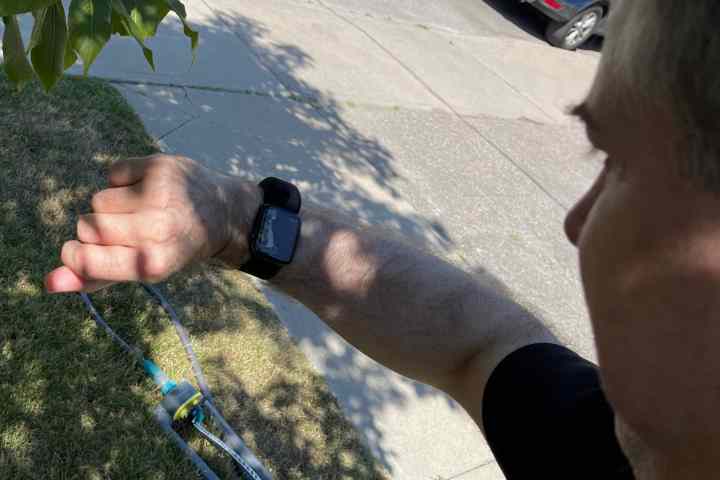
The much more complicated question is exactly who Wristcam is for. Wristcam does precisely what it’s designed to do and does a fantastic job at it. This is also more proof of the adage that the best camera is the one you have with you.
After using Wristcam for several days, I came away very impressed, but I also had to ask myself if this was something I really needed. While there have been occasions in the past when I wished I could have captured a photo on a long cycling excursion, I’m not sure if those missed opportunities are enough to warrant something like Wristcam instead of simply bringing my iPhone along for the ride instead.
Consider that for Wristcam’s $299 asking price, you can easily get a GoPro Hero 8, which most outdoor adventure enthusiasts would agree is a much better camera, capable of shooting 4K video and 12MP photos. Wristcam may win out in portability, but you’re sacrificing a lot of photographic quality to achieve that.
This price tag leaves Wristcam as a fairly niche product. It’s something for the more casual outdoor enthusiast or the person who regularly likes to go on walkabout without their iPhone. It could also appeal to folks using Apple’s Family Setup feature to use an Apple Watch without owning an iPhone. There’s no doubt that Wristcam is the best way to add a camera to your Apple Watch, and it works very well, but it doesn’t even come close to replacing an iPhone.



